You can find a list of Stephen Hawking’s publications on the Hawking.org website. It starts with his 1965 PhD thesis. This is said to have “borrowed from Roger Penrose’s theorem which described a ‘spacetime singularity’ being present in the centre of black holes”. Penrose was one of Hawking’s PhD examiners. Seven out of Hawking’s first ten papers concerned singularities.
Singularities and the geometry of spacetime
One of Hawking’s early papers was singularities and the geometry of spacetime dating from 1966. At 91 pages it’s curiously long. The content is curious too. On page 26 he referred to the Schwarzschild metric and the “apparent” singularity at r=2m but said “this is simply due to a bad choice of coordinates”. It’s as if Hawking had never read Einstein’s 1939 paper on a stationary system with spherical symmetry consisting of many gravitating masses. That’s where Einstein said it would take light and matter an infinite time to reach the event horizon. On page 37 Hawking talked about vorticity but there’s no connection with electromagnetism. It’s as if Hawking had never read Maxwell’s on physical lines of force. That’s where Maxwell presented his theory of molecular vortices. On page 76 Hawking talked of “such a strong gravitational field that even the ‘outgoing’ light rays from it are dragged back”. It’s as if Hawking had never read Einstein’s fundamental ideas and methods of the theory of relativity. That’s where Einstein said the curvature of rays of light occurs only in spaces where the speed of light is spatially variable:
 Fair use excerpt from Einstein’s fundamental ideas and methods of the theory of relativity
Fair use excerpt from Einstein’s fundamental ideas and methods of the theory of relativity
Hawking didn’t know that the speed of light is not constant. Or that light speeds up as it ascends. Or that in a strong gravitational field, it speeds up even more. And on page 30 he said this: “whether physically realistic solutions with inhomogeneities would contain singularities is a question of great importance for cosmology”. Hawking didn’t know that a gravitational field is a place where space is neither homogeneous nor isotropic. So Hawking didn’t understand the first thing about gravity, so he didn’t understand the first thing about black holes either. Or singularities. That’s presumably why in his conclusion on page 87 he said this:“the examples of the Reissner-Nordström and Kerr solutions show that the addition of a small amount of electric charge or angular momentum could completely alter the nature of the singularity, causing the matter to fall through a ‘wormhole’ and emerge into another universe”. It would seem that Hawking’s concept of “physically realistic” was somewhat different to mine.
Singularities in collapsing stars and universes
As to how Hawking arrived at such strange concepts it’s hard to say. His 1969 paper singularities in collapsing stars and expanding universes was co-authored with his supervisor Dennis Sciama, who was clearly influential. It starts by referring to Chandrasekhar saying that there’s no equilibrium situation for a cold non-rotating star bigger than 1.5 solar masses. However the Chandrasekhar limit doesn’t actually mean a star will collapse to a point singularity, and nor does the Tolman-Oppenheimer-Volkoff limit. In their 1939 paper on massive neutron cores Oppenheimer and Volkoff said the star contracts indefinitely although more and more slowly such that the solution is quasi-static. Oppenheimer’s next paper, written with Hartland Snyder, was on continued gravitational contraction. It’s described as the frozen-star paper. You can find a reference to it in the 1971 Physics Today article introducing the black hole by Remo Ruffini and John Wheeler:
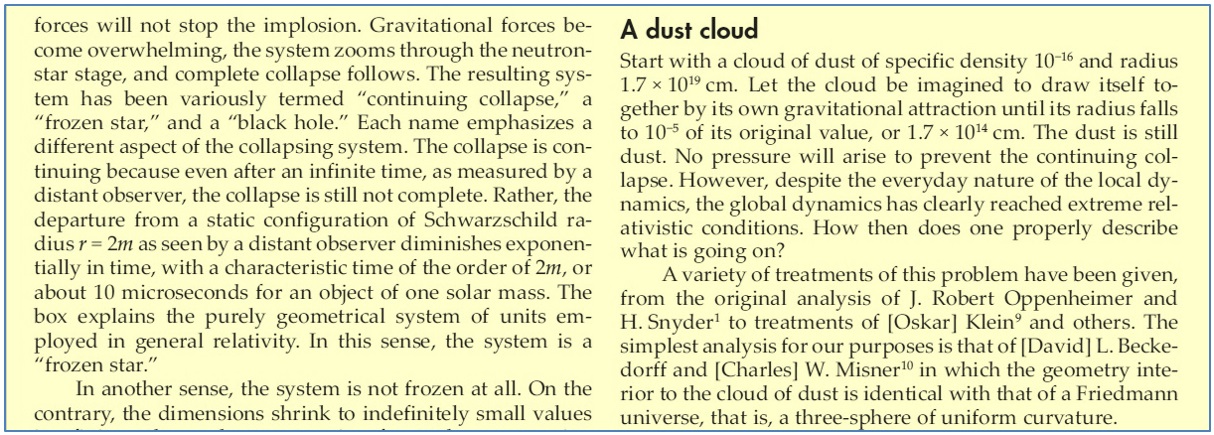 Fair use excerpt from introducing the black hole by Remo Ruffini and John Wheeler
Fair use excerpt from introducing the black hole by Remo Ruffini and John Wheeler
They said in a sense the system is a frozen star, and in another sense the system is not frozen at all. They said “according to figure 3, the fall of a test particle towards a black hole ends at r=2m as seen by a distant observer. The fall ends at r=0 according to someone falling with the test mass itself. How can two different versions of the truth be compatible?” They can’t. Ruffini and Wheeler answer by saying time goes beyond infinity and introduce Kruskal coordinates. However it’s the wrong answer because Kruskal seconds last forever. Hence it would seem that Hawking was living in some “golden age“ where general relativity was being resurrected, but as a zombie doppelganger bearing little resemblance to the original. Hence in singularities in collapsing stars and expanding universes we again read that “the surface is in such a strong gravitational field that even light is dragged inwards”. Again this misses the crucial point that a gravitational field is a place where the speed of light varies, like Einstein said. That should have told Hawking and Sciama that the ascending light beam doesn’t get dragged back, it speeds up. The stronger the gravitational field, the more it speeds up. Instead they said “the prediction of singularities may indicate that general relativity breaks down under certain conditions”. They didn’t consider that the prediction was wrong. They also said “it may be that quantum effects will save the situation, but one would not expect them to play a significant role until the radius of curvature of space becomes of the order of 10-13 cm”. Curvature of space! They didn’t even know the difference between curved space and curved spacetime.
Gravitational collapse and space-time singularities
All in all when it came to Einstein’s general relativity, Hawking was in a position of ignorance. His sixty years in a nutshell hints at this. Einstein is not mentioned. But Roger Penrose is. Penrose wrote his “epoch-making” paper gravitational collapse and space-time singularities in 1964. You can find a pdf online. He started by talking about quasars: “the discovery of the quasistellar radio sources has stimulated renewed interest in the question of gravitational collapse. It has been suggested by some authors [1] that the enormous amounts of energy that these objects apparently emit may result from the collapse of a mass of the order of (106 – 108)Mⓧ to the neighborhood of its Schwarzschild radius, accompanied by a violent release of energy”. He didn’t know why, which makes it plain that he hadn’t read Einstein’s fundamental ideas and methods of the theory of relativity either. Again, that’s where Einstein said a gravitational field is a place where the speed of light is spatially variable. That would surely have set Penrose off in a different direction, because a falling body falls faster and faster whilst the speed of light is getting slower and slower, and something has surely got to give:
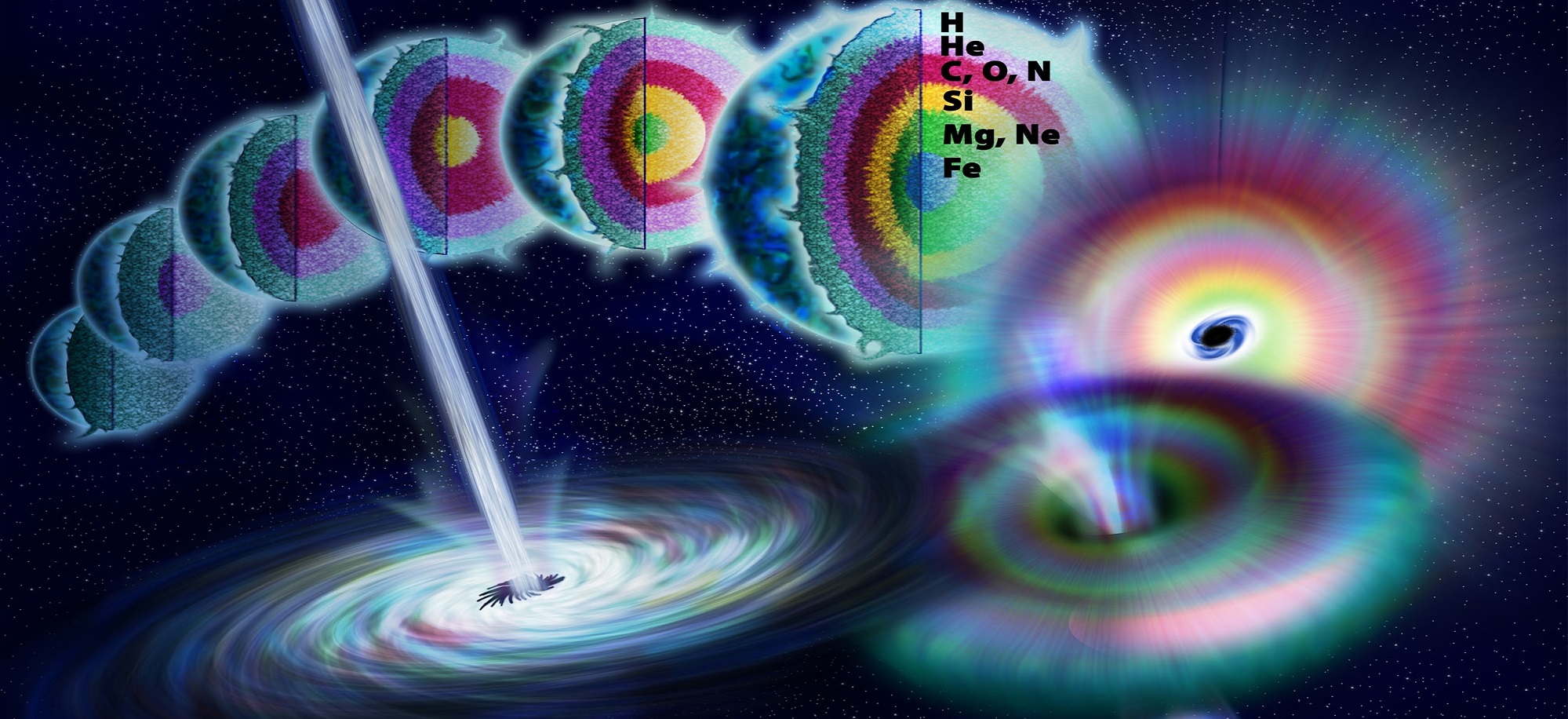 Gamma ray burst image by Nicolle Rager Fuller of the National Science Foundation, see Wikipedia
Gamma ray burst image by Nicolle Rager Fuller of the National Science Foundation, see Wikipedia
It’s plain however that Penrose did read Oppenheimer and Snyder’s frozen star paper on continued gravitational contraction. He referred to it, saying “the general situation with regard to a spherically symmetrical body is well known [2]”. But then he flatly contradicted it. He said the collapsing star continues to contract until a physical singularity is encountered at r=0. In saying this Penrose also contradicted Einstein’s 1939 paper, which said the infalling matter never reaches the event horizon. Penrose even contradicted himself. He said “as measured by local comoving observers, the body passes within its Schwarzschild radius r=2m”. Then he says “to an outside observer the contraction to r=2m appears to make infinite time”. It’s those two different versions of the truth again, and they cannot both be right. But Penrose just swept the issue under the carpet.
Past-future asymmetry of the gravitational field of a point particle
Penrose also referred to David Finkelstein’s 1958 paper past-future asymmetry of the gravitational field of a point particle. Wikipedia refers to it too, in the golden age section of the black hole article. It says Finkelstein “identified the Schwarzschild surface as an event horizon, ‘a perfect unidirectional membrane: causal influences can cross it in only one direction’”. The Wikipedia article says this did not strictly contradict Oppenheimer’s results, when it absolutely did. That’s might come as something of a surprise, but not as big a surprise as Finkelstein’s actual paper. Again you can find a pdf online. It claims to be an “analytic extension of the Schwarzschild exterior solution” but it isn’t. Finkelstein totally ignored Einstein’s 1939 paper. He ignored the crucial issue wherein an infalling body never crosses the event horizon. Instead he referred to Einstein and Rosen’s 1935 “wormhole” paper the particle problem in the theory of general relativity. That’s where Einstein and Rosen talked about a mathematical representation of physical space wherein a particle is represented by a bridge connecting two sheets. Finkelstein then talked about particles and antiparticles. He said they “fall into two classes according to whether their surfaces are permeable inwards or outwards, one class being the time-reversal of the other”. The paper is extremely speculative, and isn’t much to do with relativity. Or particle physics. Or scientific evidence of how a positron moves in a magnetic field. We know that the positron has the opposite chirality to the electron, and can be treated as time-reversed electron where the spin ½ Poynting-vector energy-flow goes around and around the other way:
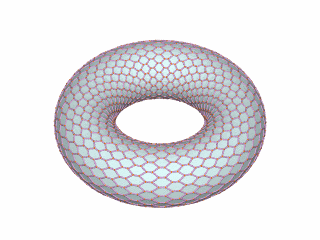
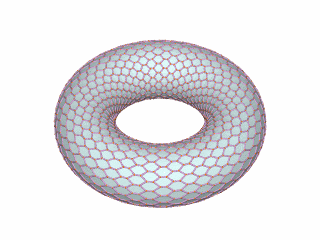
Gifs by Adrian Rossiter, see his torus animations
But it isn’t an electron going back in time, and there’s nothing to support Finkelstein’s notion of a one-way permeable membrane. There’s nothing to support Penrose’s point-singularity either. Or Hawking’s 91-page paper on singularities and the geometry of spacetime. Perhaps that’s why it’s 91-pages long. Because it has no support. It has no foundation. There is nothing to support Penrose-Hawking singularity theorems. It’s all built on the back of papers that are built on the back of other papers, and when you get to the bottom of it all there’s no physics at all. Instead it’s all speculation and mathematical assertion presented as proven fact. It’s a castle in the air. Speaking of which…
The four laws of black hole mechanics
Hawking’s first paper on Hawking radiation was arguably the four laws of black hole mechanics. It was co-authored with Brandon Carter and Jim Bardeen in 1973. Section 1 talks about gravitational collapse and gives three references to Hawking’s papers followed by three references to Carter’s. Section 2 talks about an integral formula and Killing vectors and covariant derivatives and anti-symmetrization. It talks about hypersurfaces and angular momentum measured asymptotically from infinity. It talks about complex conjugate null vectors and null tetrads, and it gives a great deal of mathematics including expressions like this:

It says “The coefficient ΩH is the angular velocity of the black hole, and is the same at all points of the horizon”. The trouble with that is that it ignores the infinite gravitational time dilation. The paper goes on to say “one can think of κ as the ‘surface gravity’ of the black hole”. But that ignores the way the force of gravity at some location relates to the local gradient in the speed of light. The speed of light at the horizon is zero and it can’t go lower than that. So the surface gravity κ is zero. Section 3 talks about a differential formula and the difference between the masses of two slightly different stationary axisymmetric black hole solutions. It gives copious mathematics and perfect fluids plus covariant vectors and Lie derivatives and 2-surface integrals. Then there’s changes in the number of particles and red-shifted chemical potential and the energy required to add an infinitesimal ring. The trouble with that is that if the event horizons are in the same place, the black hole masses are the same, and the infinitesimal ring of exterior matter has an infinitesimal mass. That’s no mass. All in all it comes across as an attempt to persuade, not physics.
It means Hawking radiation cannot occur
Especially when in section 4 the authors say “we shall pursue the analogy between black holes and thermodynamics and shall formulate four laws which correspond to and in some ways transcend the four laws of thermodynamics”. It’s a bald assertion, especially since that infinite time dilation means there is no motion, and so no dynamics, and so no thermodynamics. They start with the second law wherein “the area A of the event horizon of each black hole does not decrease with time”. The trouble with that is that it means Hawking radiation cannot occur. They claim that it establishes an analogy with entropy, but black holes absorb radiation, which is the exact opposite of a thermodynamic radiating body. Next comes the first law which says “any two neighboring stationary axisymmetric solutions are related by δM = κ/8π δA + ΩHδJH + ∫ΩδdJ + ∫μδdN + ∫ΩδdS”. And that “it can be seen that κ/8π in analogous to temperature”. How does that work when the temperature is an average measure of motion, and infinite time dilation means there is no motion? It just doesn’t. The authors do say “it should be emphasized that κ/8π and A are distinct from the temperature and entropy of the black hole”. That’s good. Particularly since they go on to say “the effective temperature of a black hole is absolute zero”. And there’s nothing wrong with their zeroth law which says “the surface gravity, κ of a stationary black hole is constant over the event horizon”. That’s because it’s a constant zero. But next comes their third law, which says “it is impossible by any procedure, no matter how idealized, to reduce κ to zero by a finite sequence of operations”. That’s not even wrong, because it’s already zero. The black hole is black, light can’t get out because the speed of light is zero and it can’t go lower than that. So there is no surface gravity, and by their own analogy there is no temperature. Their claims are not supported. So their laws of black hole thermodynamics are illicit, illegal, and illegitimate.
Black hole explosions?
Hawking’s next significant paper was black hole explosions? which appeared in Nature in 1974. That’s where Hawking claimed that “any black hole will create and emit particles such as neutrinos or photons at just the rate that one would expect if the black hole was a body with a temperature of (κ/2π)(ħ/2k) ≈ 10−6 (M /M)K where κ is the surface gravity of the black hole1”. He made further sweeping claims, and said the temperature will increase as the hole loses energy, and a smaller black hole would end its life in an explosion ”equivalent to about 1 million 1 Mton hydrogen bombs”. The problem comes when he tried to justify it. He talked about a massless Hermitian scalar field in an asymptotically flat spacetime. He referred to the Heisenberg operator ϕ with ai and ai+ interpreted as creation and annihilation operators. He talked about outgoing waves and waves crossing the event horizon and positive and negative frequencies. He said the number of particles created and emitted in a gravitational collapse can therefore be determined. Then he talked about a wave propagating backward in spacetime from future null infinity to past null infinity. It is spectacularly unconvincing. It demonstrates no understanding of how pair production works, how gravity works, what a black hole is. It’s one great big sweeping set of lost-in-maths assertions that lack all trace of support, with neither explanation nor foundation.
Particle creation by black holes
Hawking’s next paper was his Hawking radiation paper particle creation by black holes dating from 1975. He started by repeating his former claims, and said “it is shown that quantum mechanical effects cause black holes to create and emit particles as if they were hot bodies”. In section 1 he set the scene talking about general relativity and quantum mechanics in curved spacetime, saying “one can interpret this as implying that the time dependent metric or gravitational field has caused the creation of a certain number of particles“. Have you seen any particles being created by a gravitational field? No, and neither have I. But Hawking then said the uncertainty in the local energy can be thought of as corresponding to the local energy density of particles created by the gravitational field, even though it can’t. He repeated his claim that “the gravitational field of a black hole will create particles and emit them to infinity at just the rate that one would expect if the black hole were an ordinary body with a temperature in geometric units of κc/2π, where κ is the ‘surface gravity’ of the black hole”. Then he recognised that as the mass of the black hole decreased, the area of the event horizon would have to go down, thus “violating the law that, classically, the area cannot decrease”. That means Hawking radiation is based on a thermodynamic analogy which it breaks. Moreover Hawking then said “this violation must, presumably, be caused by a flux of negative energy”. Even though nobody has ever seen any negative energy. He then said this: “one might picture this negative energy flux in the following way. Just outside the event horizon there will be virtual pairs of particles, one with negative energy and one with positive energy”. There’s our fairy tale, from the man himself:
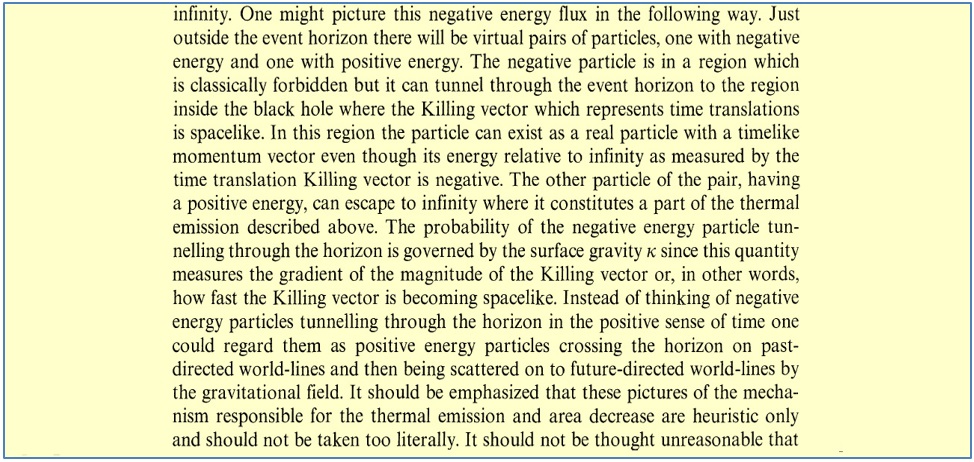 Fair use excerpt from particle creation by black holes by Stephen Hawking
Fair use excerpt from particle creation by black holes by Stephen Hawking
He said one of the particles has negative energy relative to infinity, and that the other particle of the pair “having a positive energy, can escape to infinity where it constitutes a part of the thermal emission described above”. It’s baloney, and Hawking knew it. That’s why he also offered “positive energy particles crossing the horizon on past directed world-lines and then being scattered on to future-directed world-lines by the gravitational field”. That’s particles from the future travelling back in time and bouncing off a gravitational field to become ordinary particles. It’s an even bigger fairy tale, and it’s doubtless why Hawking said “it should be emphasized that these pictures of the mechanism responsible for the thermal emission and area decrease are heuristic only and should not be taken too literally”. Then he hid behind mathematical abstraction and said “the real justification of the thermal emission is the mathematical derivation given in Section 2”. He also said “perhaps the strongest reason for believing that black holes can create and emit particles at a steady rate is that the predicted rate is just that of the thermal emission of a body with the temperature κ/2π”. You should believe in Hawking radiation because it’s predicted to be just like black body radiation. Because “there are independent, thermodynamic, grounds for regarding some multiple of the surface gravity as having a close relation to temperature”. Only there aren’t. There are no grounds for regarding surface gravity as having any relation to temperature at all.
Gravitational collapse
Section 2 is entitled gravitational collapse. Hawking said “as is now well known, the apparent singularities at r = 2M are fictitious, arising merely from a bad choice of coordinates”. Only they aren’t fictitious, so Hawking fell at the first hurdle. He fell at the second hurdle by referring to Penrose diagrams which merrily depict wormholes, the parallel universe, the antiverse, the parallel antiverse, and other mathematical fantasies:
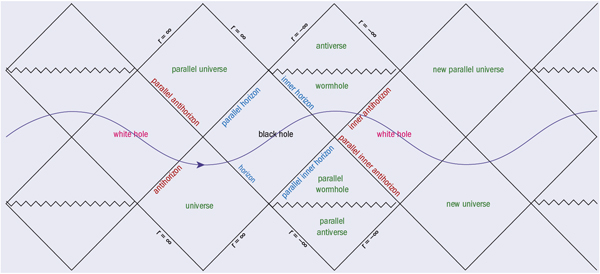 Penrose diagram from the CERN courier article Physics in the multiverse, image credit Andrew Hamilton
Penrose diagram from the CERN courier article Physics in the multiverse, image credit Andrew Hamilton
Then he conjured up a massless Hermitian scalar field operator and past null infinity and ortho-normality and supertranslations in the Bondi-Metzner-Sachs asymptotic symmetry group, plus his operators ai and ai† which “have the natural interpretation as the annihilation and creation operators for ingoing particles”. Then he talked about the zero Cauchy data and the canonical affine parameter along the null geodesic generators and said this: “in order to determine the number of particles created by the gravitational field and emitted to infinity one simply has to calculate the coefficients Bij”. He went on to say that “one can derive an asymptotic form which depends only on the surface gravity of the resulting black hole”. Then he told us all about the advanced or retarded time, and waves going to past null infinity and future null infinity. It’s science fiction, not physics. He almost stumbled across the physics when he tripped up over the frozen star and said “because the retarded time coordinate u goes to infinity on the event horizon”. But he missed it and carried on regardless, talking about an infinite total number of created particles which corresponds to a finite steady rate of emission continuing for an infinite time. He talked about the wave-packet pjn propagating backwards from future null infinity. He talked about the negative frequency components making a negative contribution to the flux into the collapsing body. That’s a negative-frequency wave going back in time, and it really is the giddy limit. There is no substance to this. The paper is all mathematical smoke and mirrors and handwaving, followed by a flourish then the rabbit from the hat: “thus one would expect the black hole also to radiate photons and gravitons thermally”. No, one would not.
Black holes and thermodynamics
Hawking’s 1975 paper black holes and thermodynamics was more of the same. To hell with no hair, he started with the claim that a black hole can have a large number of unobservable internal configurations. He talked about “recently discovered” quantum effects as if they’ve been observed through a telescope. He said radiation tunnels out through the event horizon and escapes to infinity, and that these results have been confirmed by other authors, as if they’ve replicated an experiment.
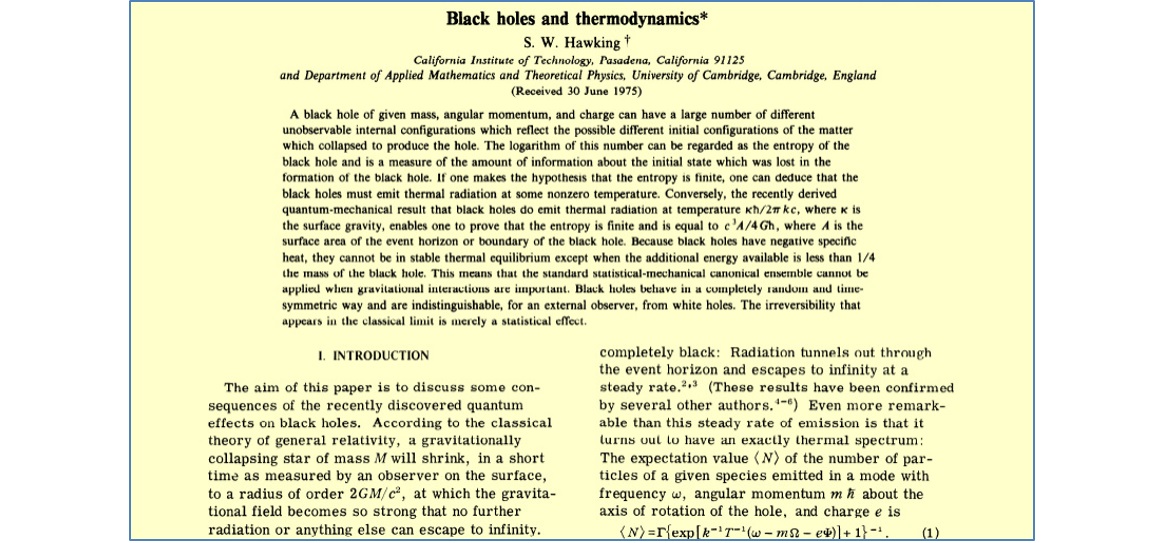 Fair use excerpt from black holes and thermodynamics by Stephen Hawking
Fair use excerpt from black holes and thermodynamics by Stephen Hawking
He said the temperature is T=κħ/2πkc where κ is the surface gravity. He said to an external observer a white hole is indistinguishable from a black hole. He said dimensionless units will be used where G=c=ħ=k=1, even though at the event horizon c=0. He said the second law is equivalent to the requirement that heat should not run uphill from a cooler system to a warmer one, even though with infinite time dilation the effective temperature of a black hole is absolute zero. He even talked about black holes emitting black holes, and about statistical fluctuations causing the black hole mass to vary, totally immune from that infinite gravitational time dilation. And for the cherry on top he said measuring the metric “places one in one of the various different branches of the wave function in the Wheeler-Everett interpretation of quantum mechanics”. That’s the many-worlds multiverse. Ye Gods. I would urge you to read these Hawking papers to appreciate just how dire they are.
Of the black hole thermodynamics
I would also urge you to read a paper on the arXiv called of the black hole thermodynamics. It was written in 2005 by Xinyong Fu. He says “Bekenstein and Hawking introduced three basic concepts relating to black hole, namely, the ‘area entropy’, ‘gravitation temperature’ and ‘thermal radiation’. He also says he “analyzes these concepts systematically and concludes that they are mostly inadequate or wrong”. He starts with area and entropy, saying the two are an increase of something but otherwise totally different. He says the entropy increases in an isolated system because density variations tend to even out towards a uniform energy density. However the increase of the area of an event horizon of a black hole is simply determined by the import of matter and energy from the exterior. Would you fill a balloon with tap water and claim its area has increased and therefore the balloon must radiate? No way. Fu tells how Bekenstein Hawking and others tried to use Boltzmann’s relation S = k ln Ω to show that a black hole’s area is entropy, Ω being the number of the microscopic states. But according to their no hair theorem the physical state of a black hole can be completely determined by just three quantities: mass, angular momentum, and charge. Hence the number of microscopic states for a black hole is one and its entropy is zero. Fu also says it’s comical that Hawking verified later that a black hole has radiation, reducing the black hole area, so contravening the original claim that established the analogy between area and entropy and set the ball rolling. He describes how Hawking came up with a mathematical expression that was similar to black body radiation, but that the similarity is mere coincidence. He says gravitational acceleration is totally different to temperature, as I know full well when I drop my pencil on a sunny day. Fu also says black body radiation is isotropic such that you can’t concentrate sunlight to yield a temperature hotter than the 6000°C surface of the sun. He goes on to say Hawking radiation is unidirectional and could be concentrated like a laser beam to yield a very high temperature, so the temperature of Hawking radiation is not T=κ/2πk. Fu also points out that stars give off light, scattering energy and increasing entropy, whilst black holes collect radiation from the space, gathering energy and decreasing entropy. He points out what’s patently blatantly obvious: the two processes aren’t similar at all.
Misleading concepts in quantum gravity
Of course some will say you shouldn’t trust Fu’s paper because it was never published in a peer reviewed journal. Some will say you shouldn’t trust Vladimir Belinksi’s paper on tunnelling through the black hole horizon either. Or Yvan Leblanc’s 2015 paper on misleading concepts in quantum gravity: black hole thermodynamics and the holographic principle. Or his fake physics: black hole thermodynamics, the holographic principle and emergent gravity. Some will doubtless say you don’t understand the mathematics dear boy, and you are therefore not qualified to comment. But don’t forget that after 44 years nobody has shown how Hawking radiation arises from any plausible physical process. What we have instead is negative frequencies, infinite frequencies, waves travelling back in time, negative mass, negative energy, and particles popping into existence. Spontaneously, like worms from mud. We have a whole pack of lies to children, we have a fairy tale that’s grown into a horror story. One that that ignores general relativity and infinite gravitational time dilation and the zero speed of light at the event horizon. What we have is fake-physics fiction that ignores why the light doesn’t get out and the very reason the black hole is black. It is breath-taking jaw-dropping pseudoscience. How on Earth did Hawking ever get away with it? Why didn’t anybody call him out? Somebody like John Baez, the man with the famous index? Perhaps it’s because Hawking is not atypical. He was the Lucasian professor of mathematics for thirty years. How he got that position I do not know. But I do know this: you should be wary of those who appeal to Einstein’s authority whilst flatly contradicting the guy. I also know that you should not fall for the Emperor’s New Clothes. Do not be overawed by the mathematical smoke and mirrors and the sleight-of-hand handwaving that leads to some rabbit-from-a-hat claim that doesn’t stand up to scientific scrutiny. Instead you should do your own research and think for yourself. About things like the information paradox.
John, in your last paragraph you say that people will state “you don’t understand the mathematics dear boy”, rightly, in the context that not understanding the mathematics implies something negative. The fact of the mathematicians position is that mathematics is a baseless language. Ever since Goedel’s undecidability theorem and Hilbert’s failed programme to put mathematics onto a solid foundation, mathematics, as currently presented, has been built on sand. Truly an edifice of the clouds. A castle in the sky. Logic no longer applies in the extremes and hence all the confusion over predictions of what infinity, zero and singularities should be interpreted as. I contend that developments in computer science actually point the way to a solution, however, I don’t know if anyone has taken my approach yet. I look forward to your paper (virtual) on the information paradox.
Glancing back at the Penrose contradiction, he seems to think you can differentiate between co-moving observers and an outside observer. This is only possible if it is made clear how they agree on the speed of light. But what speed of light are they both supposed to agree on ?I believe we are both of the opinion that the actual speed of light varies depending on the local energy density hence the speed of light is not constant. However, the speed of light in vacuum varies very little and hence is assumed for practical purposes to be constant. This holds true for most practical purposes in so far as it does not upset the calculations by introducing observable errors. According to relativity, all observers must agree on the speed of light. I take that to mean the maximum speed of light which is the practical maximum limit for the propagation of electromagnetic phenomena in vacuum. Penrose has either contradicted himself or has a way further to go to explain himself.
I don’t agree that mathematics itself is built on sand, Andy. Mathematics has a million uses in the modern world. What’s built on sand are Hawking’s claims. He abused mathematics to put up a smokescreen to hide his total lack of physics. Hawking radiation is the castle in the air, not mathematics. So is the information paradox.
.
As for the Penrose contradictions, he didn’t care. He was doing his own thing, and he was appealing to Einstein’s authority whilst flatly contradicting the guy. How he ever got away with it I don’t know. But what I do know is that he and Hawking and a few others are responsible for a lot of the problems in contemporary physics. Get general relativity right, and you know that a gravitational field is inhomogeneous space, where the speed of light varies. Between here and the event horizon it varies a lot, because at the event horizon, it’s zero, and it can’t go lower than that. Which ought to tell you something about those so-called point-singularities. And once you know that a gravitational field is inhomogeneous space, you know it isn’t curved space. So then you ask yourself what is curved space? Then you’re into electromagnetism, and the road is clear. But it never happened, because Penrose contradicted both Einstein and himself, and he won’t be explaining any of that any time soon.
I have found in my reading of Goedel and papers about him that I think a trick has been missed. They way that truth is defined, as a starting point for all other explanations, is what I think is important. You largely concern yourself with physics as the basis of reality and I have no problem with that. However, my contention is that there is a logical description of the world, entirely analogous to the physical description of the world, which sits between the concepts and the reality. The current mathematical view of the world ignores it. It claims that conceptual mathematics is analogous with the real world. It [mathematics] makes a direct connection, between concepts and reality, where it is both inappropriate and ultimately, misleading. I do not expect you to understand the thrust of my thesis in one explanation. If it simply piqches your interest that such a relationship may exist then my work here is done for now. My job is to establish the ground work for my position and look to bring you on a path to the appreciation of a different viewpoint. I only want to do this because I think it would be useful to you, as I think it should be useful to anyone. If in your estimation it isn’t worth your time then c’est la vie.
I agree that you have to get the fundamentals right first, Andy. The issue is that people peddle things like SUSY and the selectron when they don’t even know what an electron is. The issue also applies to the Standard Model too, and to cosmology. People like Hawking come up with all sorts of black hole fantasies because they don’t know how gravity works.
.
I don’t have an issue with your point concerning a logical description, or with your point that abstract mathemtcial concepts get mistaken for reality and are misleading. The map is not the territory. You can’t look up to the clear night sky and point to a world line or a reference frame. As for my time, I’m on holiday, I have time to spare. So where can I read more about what you’re saying? Have I missed an email or a hyperlink? Your last email said I will get back to you as soon as I can.
I am not on holiday, unfortunately. I have packed in my previous job and am trying to build myself a business. However, I will endeavour to put something coherent together for you.
Anybody that believes in general relativity should be committed to an insane asylum.
Alan, I recommend you read these articles:
.
https://physicsdetective.com/articles/articles-on-gravity-and-cosmology/
.
What is nowadays described as general relativity, bears scant resemblance to Einstein’s original. Einstein said a gravitational field was a place where space was “neither homogeneous nor isotropic”, such that the speed of light was “spatially variable”, and this is what causes light to curve and matter to fall down. He never said light follows the curavture of spacetime.
1. Alan, so what hypothesis or theory should we believe in ?
2. Boss, I really like the new editing 5min.function !
It works for a while Greg, then it goes away for a while. Meh.
.
Oh FFS, where did that verifying that you are human come from?
Test : “Allrighty Then ! “